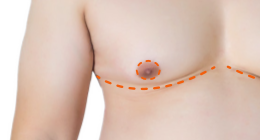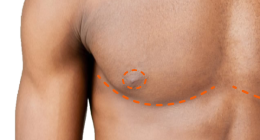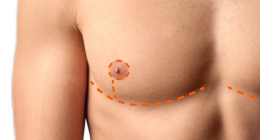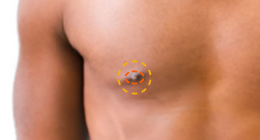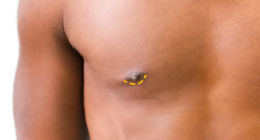Top Surgery Revisions: Causes, Costs, and Considerations
What Are Top Surgery Revisions?
Top Surgery revisions are additional surgical procedures performed to address concerns or complications after the initial Top Surgery. Revisions can improve aesthetic outcomes, resolve healing issues, or address functional problems.
Top Surgery Revisions are fairly common. While not every patient requires a revision, studies about chest masculinization surgery report revision rates ranging from 12.5% to 63.1%, depending on various factors. In recent studies reporting on overall revision rates, one found that 26.5% of patients required secondary operations1 while another reported a 23.8% overall revision rate.2 However, individual surgeons report varying rates. For example, Dr. Scott Mosser reports a revision rate of just 3-4%.
Common reasons for Top Surgery revisions include:3, 4
- Dog Ears: Excess tissue at the ends of incisions, common in Double Incision Top Surgery.
- Contour Irregularities: Extra tissue, bulges, or puckering. 28%.
- Nipple/Areola Irregularities: Issues with size, shape, or symmetry. Nipple irregularities: 5.3%. Areola irregularities: 15.8%.
- Poor Scarring: Thick, raised, or uneven scars. 14%.
- Failed Nipple Grafts:Loss of graft viability due to healing complications.
The type of Top Surgery you choose can impact the likelihood of requiring a revision. For instance, while Dog Ears are a common challenge with Double Incision Top Surgery,3 the technique tends to have lower revision rates for contour and scar-related issues when compared to the Peri-Areolar method.5 On the other hand, the Peri-Areolar approach is associated with higher revision rates overall, with some studies reporting rates as high as 55.2%.4, and this method often sees more aesthetic revisions compared to Double Incision. (34% versus 8.8 %).7 The Keyhole technique results in minimal visible scarring, but also carries a higher risk of nipple and areola asymmetry. Each technique presents unique considerations that can influence the need for a revision surgery.
Revisions are typically delayed 6-12 months after the original Top Surgery. This allows time for full healing and ensures that the final results of the initial surgery are evident, as minor issues may resolve on their own without needing a revision.
The cost of a Top Surgery revision depends on your surgeon's policies and the extent of the revision required. Many surgeons include revisions within the cost of the original surgery if they are performed within a specific time frame, often one year. In this case, you may only need to pay a nominal fee to cover materials or anesthesia.
Minor revisions, which are often less complex, can usually be performed in the surgeon's office under local anesthesia and typically cost between $500 and $1,000. In contrast, major revisions that require general anesthesia and an operating room are significantly more expensive.
Insurance coverage for revisions may be available if the procedure is found to be medically necessary.
Revisions are a common part of the Top Surgery journey but there are a few things you can take to make a secondary procedure less likely. Giving your body enough time to heal fully before considering a revision is crucial, as many concerns can improve naturally during the recovery process. Quitting smoking is another important step, as smoking significantly increases the risk of complications, including poor wound healing and graft failure. Last but not least, closely following your surgeon's post-operative instructions is essential to prevent complications and promote optimal healing, which can reduce the likelihood of needing a revision.
While it's ideal to avoid additional procedures, Top Surgery revisions can significantly improve outcomes, if needed. Revisions are often less intensive than the original surgery and can be a valuable step toward achieving your surgery goals. If after healing, you're unsatisfied with your results, consult with your surgeon to explore your options for a revision surgery.
References:
1. Masculinizing Top Surgery: A Systematic Review of Techniques and Outcomes. Wilson SC, Morrison SD, Anzai L, Massie JP, Poudrier G, Motosko CC, Hazen A. Ann Plast Surg. 2018 Feb 2.
2. A Review of 101 Consecutive Subcutaneous Mastectomies and Male Chest Contouring Using the Concentric Circular and Free Nipple Graft Techniques in Female-to-Male Transgender Patients. Knox ADC, Ho AL, Leung L, Hynes S, Tashakkor AY, Park YS, Macadam SA, Bowman CC. (Vancouver, British Columbia, Canada; and Chicago, Ill.) Plast Reconstr Surg. 2017 Jun;139(6):1260e-1272e.
3. Masculine Chest-Wall Contouring in FtM Transgender: a Personal Approach. Lo Russo G, Tanini S, Innocenti M. (Department Plastic and Reconstructive Microsurgery, Careggi Universital Hospital, Florence, Italy) Aesthetic Plast Surg. 2017 Apr;41(2):369-374. Epub 2017 Feb 7.
4. Chest-wall contouring surgery in female-to-male transgender patients: A one-center retrospective analysis of applied surgical techniques and results. Kääriäinen M, Salonen K, Helminen M, Karhunen-Enckell U. Scand J Surg. 2017 Mar;106(1):74-79. Epub 2016 Jun 23.
5. Female-to-Male Chest Reconstruction: A Review of Technique and Outcomes. Donato DP, Walzer NK, Rivera A, Wright L, Agarwal CA. Ann Plast Surg. 2017 Sep;79(3):259-263.
6. Surgical Indications and Outcomes of Mastectomy in Transmen: A Prospective Study of Technical and Self-Reported Measures. van de Grift TC, Elfering L, Bouman MB, Buncamper ME, Mullender MG. Plast Reconstr Surg. 2017 Sep;140(3):415e-424e.
7. Top Surgery in Transgender Men: How Far Can You Push the Envelope? Bluebond-Langner, Rachel M.D.; Berli, Jens U. M.D.; Sabino, Jennifer M.D.; Chopra, Karan M.D.; Singh, Devinder M.D.; Fischer, Beverly M.D. Plastic & Reconstructive Surgery: April 2017 - Volume 139 - Issue 4 - p 873-882e.
Last updated:01/22/25
